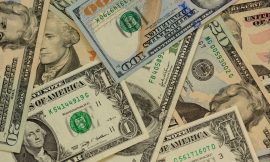The dollar index (DXY00) today is down by -0.51%. The dollar today extended Monday’s losses to a 2-3/4 month low. Concerns that US tariffs will spark a trade war that undercuts economic growth are weighing on the dollar. Also, today’s decline in the 10-year T-note yield to a 4-1/2 month low has weakened the dollar’s interest rate differentials. The dollar has some support for increased liquidity demand due to today’s slide in equity markets.
Market attention this week will focus on tonight’s address to a joint session of Congress by President Trump. On Wednesday, the Feb ISM services index will be released (expected -0.1 to 52.7). On Friday, Feb nonfarm payrolls are expected to rise by +160,000, and the Feb unemployment rate is expected to remain unchanged at 4.0%. Meanwhile, Feb average hourly earnings are expected to be unchanged from Jan at +4.1% y/y. Also on Friday, Fed Chair Powell gives the keynote speech on the economic outlook at Chicago Booth’s 2025 US Monetary Policy Forum.
The Barchart Brief: Your FREE insider update on the biggest news stories and investing trends, delivered midday
The markets are discounting the chances at 12% for a -25 bp rate cut at the next FOMC meeting on March 18-19.
EUR/USD (^EURUSD) today is up by +0.24%. The euro rose to a 2-3/4 month high today after the EU said it would propose loans to increase defense spending in the region, which bolsters expectations that more spending would be positive for the Eurozone economy. The euro was supported by today’s report that the Eurozone Jan unemployment rate remained at a record low. Gains in the euro are contained on concern President Trump might further expand his tariff policies on US imports from the EU, which would dampen growth prospects in the Eurozone.
The Eurozone Jan unemployment rate was unchanged at a record low of 6.2%, showing a stronger labor market than expectations of 6.3%.
The European Union (EU) today proposed extending 150 billion euros in loans to boost defense spending in the EU and activating a mechanism allowing countries to spend an additional 650 billion euros on defense over four years without triggering budgetary penalties.
Swaps are discounting the chances at 99% for a -25 bp rate cut by the ECB at the March 6 policy meeting.
USD/JPY (^USDJPY) today is down by -0.81%. The yen today added to Monday’s advance and climbed to a 4-3/4 month high against the dollar. US tariffs went into effect today on Canadian, Chinese, and Mexican goods, and Canada and China retaliated with their own tariffs on US goods, sparking concerns about escalating global trade tensions and boosting safe-haven demand for the yen. Higher Japanese government bond yields also supported the yen after the 10-year JGB bond yield today rose to a 1-week high of 1.432%. In addition, today’s slump in the Nikkei Stock Index to a 5-1/2 month low boosted safe-haven demand for the yen. Today’s Japanese economic news was mostly weaker than expected and bearish for the yen.
The Japan Feb consumer confidence index unexpectedly fell -0.2 to a 2-year low of 35.0, weaker than expectations of an increase to 35.3.
Japan's Q4 capital spending unexpectedly fell -0.2% y/y, weaker than expectations of +5.0% y/y and the first decline since Q1 of 2021. Q4 capital spending ex-software rose +3.1% y/y, weaker than expectations of +4.7% y/y.
The Japan Jan jobless rate was unchanged at 2.5%, showing a weaker labor market than expectations of 2.4%.
April gold (GCJ25) today is up +19.80 (+0.68%), and May silver (SIK25) is down -0.050 (-0.15%). Precious metals prices today are mixed. Today’s slide in the dollar index to a 2-3/4 month low is bullish for precious metals. Also, a decline in global government bond yields and weakness in equity markets supported precious metals. In addition, escalating global trade tensions have sparked safe-haven buying of precious metals after US tariffs went into effect today against Canada, China, and Mexico, and Canada and China retaliated with their tariffs on US goods. Finally, fund buying is also supporting gold prices as long gold positions in ETFs rose to a 14-1/2 month high Monday. Silver prices are under pressure because of concerns that worsening trade tensions will lead to slower global economic growth and weaker demand for industrial metals.
On the date of publication, Rich Asplund did not have (either directly or indirectly) positions in any of the securities mentioned in this article. All information and data in this article is solely for informational purposes. For more information please view the Barchart Disclosure Policy here.
More news from Barchart
- What is Gold’s Next Upside Target?
- Commodity Market Roundup- February’s Top Performers and Underperformers
- Are the Frictions Between the U.S. and Mexico Bullish for Silver?
- Politicians Are Buying This 1 Gold ETF Hand Over Fist as Prices Hit Record Highs
The views and opinions expressed herein are the views and opinions of the author and do not necessarily reflect those of Nasdaq, Inc.




